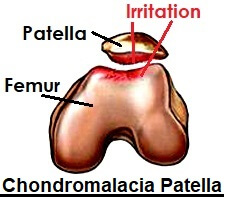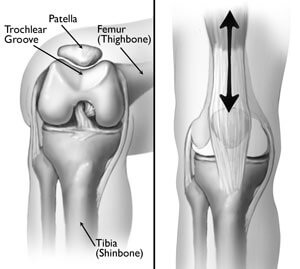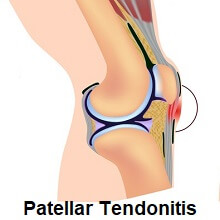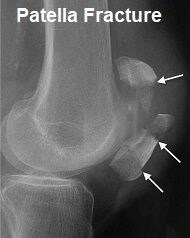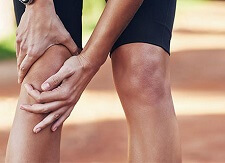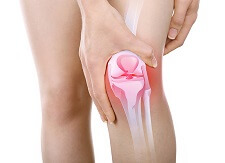- Home
- Knee Pain Diagnosis
- Kneecap Pain
Knee Cap Pain
Written By: Chloe Wilson, BSc(Hons) Physiotherapy
Reviewed by: KPE Medical Review Board
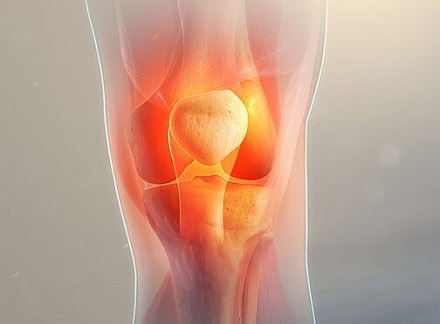
Knee cap pain is a common problem that affects people of any age.
Anything which affects the position or movement of the knee cap can cause pain, inflammation and degeneration.
There may be a problem with the kneecap bone itself, the cartilage that lines it, or tightness or weakness in the surrounding muscles.
Kneecap pain, aka patellofemoral pain, often feels like a dull aching or burning sensation at the front of the knee or behind the kneecap.
Here we will look at the common causes of knee cap pain, how they present and how to treat patellofemoral pain.
Knee Cap Anatomy
The kneecap aka patella is a small triangle shape bone that sits inside the joint tendon of the quadriceps muscles. It rests in a groove on the femur (thigh bone) known as the patellar/trochlear groove and glides up and down in this groove as the knee moves.
The back surface of the kneecap is lined with the thickest layer of cartilage in the whole body. This is because such large forces go through it. For example when you squat, a force equivalent to eight times your body weight goes through the kneecap.
But why do we have kneecaps? The knee cap is functionally important because it increases the leverage at the knee joint. This increases the strength of the knee by approximately 30% with extension activities like kicking.
Causes Of Knee Cap Pain
The eight most common causes of knee cap pain are:
1. Chondromalacia Patella
Chondromalacia is a common cause of knee cap pain, especially in young adults and adolescents. Thinning of the cartilage that lines the back of the knee cap results in anterior knee pain.
Chondromalacia patella causes patellofemoral pain that tend to be worse when you first get up from sitting or when climbing stairs. It can also cause a grinding/grating sensation.
Chondromalacia patella is usually caused by muscle tightness and weakness, overuse or altered biomechanics in the leg.
Find Out More: Chondromalacia: Causes, Symptoms & Treatment
2. Runner's Knee
Runner's knee is a very common cause of knee cap pain. It can affect anyone from athletes to office workers - don't be fooled by the name!
Runner's Knee is caused by patella maltracking, a problem with how the kneecap moves. This is usually due to muscle tightness, weakness or abnormal biomechanics e.g. foot position.
Runner's Knee is also known as anterior knee pain or patellofemoral pain syndrome and is a common cause of chronic knee cap pain.
The symptoms of Runner's Knee tend to come on gradually over time and people typically experience an achy pain around the front of the knee and under the patella.
Patellofemoral pain syndrome tends to be worse after prolonged activity and people often complain of knee cap pain when coming down stairs.
Find Out More: Runner's Knee - Causes & Treatment
3. Patellar Tendonitis
More commonly known as Jumper's Knee, patellar tendonitis usually results in kneecap pain just below the patella.
Patellar tendonitis is caused by damage to the patella tendon from repetitive activities like jumping
and kicking.
The most defining symptom of jumper's knee is anterior knee pain when pressure is applied just below the knee on the tendon.
Knee cap pain from patellar tendonitis also tends to be worse with and after activity and first thing in the morning. Patellar tendonitis is a common cause of chronic knee pain in runners and a common cause of pain just below the knee.
Patellofemoral pain associated with patellar tendonitis tends to get gradually worse over time as the tendon weakens and if left untreated, the tendon may tear completely.
Find Out More: Jumper's Knee - Causes & Treatment
4. Quadriceps Tendonitis
Another possible cause of knee cap pain is quadriceps tendonitis. Quadriceps Tendonitis typically affects people who do activities with lots of sprinting, jumping and quick changes in direction, particularly if they have recently upped their training.
It can also affect non-athletes, particularly those with tight leg muscles, altered foot biomechanics and obesity.
Quadriceps tendinopathy causes pain and tenderness just above the knee cap. There may be swelling on top of the knee and the knee may feel stiff and weak.
It is really important to rest from all aggravating activities with quads tendonitis otherwise the knee cap pain will get gradually worse. When caught early, recovery may only take a few weeks, whereas if treatment is delayed, it can take months.
Find Out More: Quadriceps Tendonitis - Causes & Treatment
5. Knee Bursitis
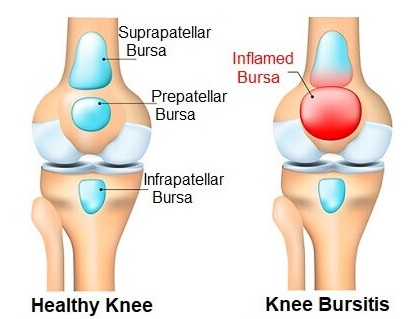
The most common cause of knee cap pain with swelling is bursitis where there is irritation and inflammation of one of the bursa that sit near the knee cap.
Bursa are small fluid-filled sacs that sit between structures around the knee such as the bones and tendons. They allow smooth movement at the knee, preventing any friction as the knee moves.
However, if there is excessive friction or pressure on one of the bursa then it will become inflamed and fill with excess fluid. There are three types of knee bursitis that can cause knee cap pain and swelling:
- Suprapatellar Bursitis: just above the knee in the lower thigh
- Prepatellar Bursitis: right in front of the kneecap
- Infrapatellar Bursitis: just below the kneecap at the top of the shin
Inflammation in any of these can limit knee movement and affect daily activities due to pain and swelling.
Find out More: Knee Bursitis - Causes & Treatment
6. Dislocated Patella
One of the more serious causes of knee cap pain is a dislocated kneecap. A patella dislocation occurs when the knee cap is forced out of the patellar groove, usually after a knee injury, or from twisting awkwardly.
When the patella dislocates there is a visible deformity with a large bulge to the side of the knee, most
commonly the outer side. There also tends to be lots of swelling if the kneecap dislocates, and, obviously, knee cap pain.
A patellar dislocation is a medical emergency and the knee cap needs relocating, putting back in place, by a doctor as soon as possible.
Kneecap dislocation is usually accompanied by damage to the ligaments that hold the knee cap in place which can make you prone to dislocating again in the future. Treatment consists of a rehab program and in some cases surgery may be necessary.
Find out More: Kneecap Dislocation - Causes & Treatment
7. Patella Fractures
Another serious cause of knee cap pain is a patella fracture when the kneecap gets broken. This tends to occur due to a fall from a height or a massive force through the bone.
There may be one clean break or in most cases, the patella will break into several pieces. There tends to be severe knee cap pain, swelling and obvious deformity.
Depending on the severity of the injury, the leg may be put in a brace/cast to prevent movement for a few weeks while the bone heals, or surgery may be required to fix the fragments back together.
If the knee injury is severe, part or all of the kneecap may need to be removed.
Find out More: Patella Fractures - Causes & Treatment
8. Patella Alta
Patella alta, aka high riding patella, is a rare but potentially serious cause of knee cap pain.
With patella alta, the kneecap sits higher than normal in a shallower part of the patellofemoral groove on the thigh bone. This means that the kneecap is less well supported and thus moves excessively which can lead to secondary knee problems.
Instability and kneecap dislocation is common with patella alta. Kneecap pain from high riding patella is worse after prolonged periods of sitting, on stairs, walking up and down slopes and squatting.
Find Out More: Patella Alta: Causes & Treatment
9. Patellofemoral Arthritis
Patellofemoral arthritis is a common cause of chronic knee cap pain in people over the age of 60. Arthritis is when there is wear and tear in the bones and cartilage, which can affect any of the knee bones.
Patellofemoral arthritis leads to a narrowing of the space between the kneecap and the groove it sits in on the femur.
Anterior knee pain from patellofemoral arthritis is usually worse with any activities that put pressure through the patella
such as squatting, climbing stairs and kneeling.
It also sometimes produces a cracking or grating noise/sensation when
you move your knee.
Find Out More: Patellofemoral Arthritis
Knee Cap Pain FAQs
What Causes Pain Under The Knee Cap? Pain under the kneecap can be due to a number of problems. If the pain is felt on the back of the kneecap it is usually a problem with the cartilage on the back of the patella, most typically Chondromalacia Patella or Runners Knee. The pain tends to come on gradually and gets worse after sitting for a while or doing lots of exercise.
If there is pain below the knee cap, the most common causes are patellar tendonitis or infrapatellar bursitis.
What Causes Pain Above The Knee Cap? When knee cap pain is felt just above or at the top of the kneecap, the most likely cause is Quadriceps Tendonitis. The top of the patella is usually tender to touch and the knee pain gets worse with activity. If there is a localised pocket of swelling, it is likely due to suprapatellar tendonitis.
If there is also marked weakness and swelling, it may indicate a complete quads tendon rupture which will likely need surgery.
What Causes Sharp Pain In The Knee Cap? Sharp knee cap pain is usually caused by either damage to the cartilage on the back of the kneecap, or a patella fracture - a break in the bone. Sharp knee pain is usually worse with movement and may be intense.
What Causes Knee Cap Swelling? There are a number of things that can cause swelling at the knee cap. A defined pocket of swelling that resembles a squashy orange is usually caused by knee bursitis. If there is a lump in the tendon it usually indicated tendonitis. Severe swelling all around the front of the knee is usually due to a kneecap injury
How Do You Treat Kneecap Pain? Treatment for patellofemoral pain will depend on the type of knee injury. In most cases, knee cap pain can be treated with a combination of exercises and physical therapy, knee ice wraps, painkillers and a knee brace. You can find out everything you need to know in the knee joint pain treatment section.
Knee Cap Pain Summary
Knee cap pain may caused by strains or tears of the muscle tendons surrounding the knee, overexertion of muscles, tendons or ligaments around the knee, a misalignment of the patella, or a fracture of the knee cap.
Symptoms may include patellofemoral pain during activities such as running, climbing stairs, kneeling, or squatting; swelling of the knee or a grinding sensation in the joint; tenderness in the knee cap area; or difficulty moving the knee.
Knee cap pain treatment options usually include rest and ice, over-the-counter anti-inflammatory medications, physical therapy, corticosteroid injections, or surgery depending on the severity of the injury.
You might also be interested in the following articles:
- Knee Pain & Popping
- Swollen Knee Treatment
- Front Knee Pain
- Pain Below Knee
- Side Knee Pain
- Pain Behind The Knee
- Burning Knee Pain
- Knee Pain On Stairs
Page Last Updated: 04/10/23
Next Review Due: 04/10/25
